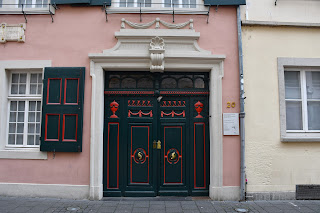Germany Trip – Day 6: Koblenz and Bonn
Riding through the Rhine Valley offers very different views to my previous trips on this journey. While the area between Cologne, Düsseldorf, Essen, and Dortmund is a more or less contiguous suburban expanse, the Rhine south of Bonn has very few settlements until the 50-kilometre distant Koblenz. Unlike the stretch between Aachen and Maastricht, for instance, the landscape there is hilly, with an occasional fort or palace nestled comfortably above the river.
After
arriving in Koblenz, I immediately took another train to Lahnstein. The quiet
town itself is rather unremarkable, except it offers great views of Stolzenfels
Castle just across the river. I did not trek all the way to the castle, which
would have involved crossing a bridge over half an hour away from the main
viewing area. Instead, I took the train back to Koblenz, which I briefly
toured. The city’s main attractions include the Palace of the
archbishop-electors of Trier, the Basilica of Saint Castor, and the confluence
of the Moselle and Rhine, which is guarded by a massive equestrian statue of
William I, memorialised as the unifier of Germany. The name Koblenz actually
comes from the Latin “Cōnfluentēs,” or “Confluence.”
From
Koblenz, I took the train back in the direction from which I came, arriving in
Bonn around lunchtime. Architecturally, Bonn is not a remarkable city, and its
attractions are decidedly provincial: a rococo town hall, a prince-elector’s
palace, and a few churches. However, Bonn draws its fame from two facts: it is
the birthplace of Beethoven (who is memorialised at every corner) and it served
as the capital of Western Germany. For those reasons alone it is interesting to
see Bonn, even if it involves a wry curiosity about how this town could ever
have been the capital of one of the world’s biggest economies, or indeed, the
birthplace of any genius.
My final
stop for the day was Drachenburg, a hilltop castle whose environs can be
reached by tram from Bonn or by a train from farther afield. From the station,
I walked for about half an hour through a very peaceful forest, which is
traversed by a gurgling manmade stream etched into the landscape at the peak of
German Romanticism. Similarly, the castle itself is really a villa built
towards the end of the nineteenth century with all the amenities a person of
the age may require. The artistic sensibilities and cultural touchstones of the
era are particularly visible in the stained glasses, which depict sets (usually
five) of particularly popular personages classed by profession. These include
composers like Wagner and Offenbach, or poets like Heine and Goethe.



























Comments
Post a Comment